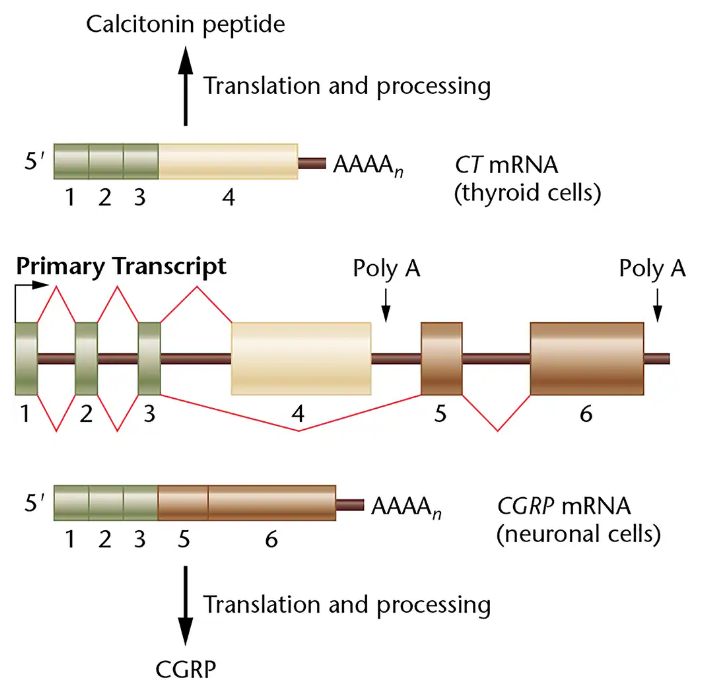 Back
BackProblem 1a
How do we know that alternative splicing enables one gene to encode different isoforms with different functions?
Problem 1b
How do we know that misregulation of mRNA stability and decay is a contributing factor in some cancers?
Problem 1c
How do we know that double-stranded RNA molecules can control gene expression?
Problem 1d
How do we know that microRNAs negatively regulate target mRNAs?
Problem 2
Write a short essay describing how an mRNA may be regulated in three different ways by specific cis-elements and RBPs.
Problem 3
List three types of alternative splicing patterns and how they lead to the production of different protein isoforms.
Problem 4
Consider the CT/CGRP example of alternative splicing show. Which different types of alternative splicing patterns are represented?
Problem 5
Explain how the use of alternative promoters and alternative polyadenylation signals produces mRNAs with different 5' and 3' ends.
Problem 6
Explain how a tissue-specific RNA-binding protein can lead to tissue-specific alternative splicing via splicing enhancers or splicing silencers.
Problem 7
The regulation of mRNA decay relies heavily upon deadenylases and decapping enzymes. Explain how these classes of enzymes are critical to initiating mRNA decay.
Problem 8
Nonsense-mediated decay is an mRNA surveillance pathway that eliminates mRNAs with premature stop codons. How does the cell distinguish between normal mRNAs and those with a premature stop?
Problem 9
AU-rich elements (AREs) are cis-elements in mRNAs that regulate stability and decay. How is it possible that a single mRNA sequence element can serve to stabilize an mRNA in some cases and lead to its decay in other scenarios?
Problem 10
What are processing bodies (P bodies), and what role do they play in mRNA regulation?
Problem 11
In 1998, future Nobel laureates Andrew Fire and Craig Mello, and colleagues, published an article in Nature entitled, 'Potent and Specific Genetic Interference by Double-Stranded RNA in Caenorhabditis elegans.' Explain how RNAi is both 'potent and specific.'
Problem 12
Present an overview of RNA interference (RNAi). How does the silencing process begin, and what major components participate?
Problem 13
RNAi may be directed by small interfering RNAs (siRNAs) or microRNAs (miRNAs); how are these similar, and how are they different?
Problem 14
miRNAs target endogenous mRNAs in a sequence-specific manner. Explain, conceptually, how one might identify potential mRNA targets for a given miRNA if you only know the sequence of the miRNA and the sequence of all mRNAs in a cell or tissue of interest.
Problem 15
In principle, RNAi may be used to fight viral infection. How might this work?
Problem 16
Competing endogenous RNAs act as molecular 'sponges.' What does this mean, and what do they compete with?
Problem 17
While circular RNAs were first described long ago, they have only recently been investigated for function. What are their known and suspected functions in the cell?
Problem 18
How are mRNAs stored within the cell in a translationally inactive state, and how can their translation be stimulated?
Problem 19
How and why are eukaryotic mRNAs transported and localized to discrete regions of the cell?
Problem 20
How is it possible that a given mRNA in a cell is found throughout the cytoplasm but the protein that it encodes is only found in a few specific regions?
Problem 21
How may the covalent modification of a protein with a phosphate group alter its function?
Problem 22
What role do ubiquitin ligases play in the regulation of gene expression?
Problem 24
We discussed several specific cis-elements in mRNAs that regulate splicing, stability, decay, localization, and translation. However, it is likely that many other uncharacterized cis-elements exist. One way in which they may be characterized is through the use of a reporter gene such as the gene encoding the green fluorescent protein (GFP) from jellyfish. GFP emits green fluorescence when excited by blue light. Explain how one might be able to devise an assay to test for the effect of various cis-elements on posttranscriptional gene regulation using cells that transcribe a GFP mRNA with genetically inserted cis-elements.
Problem 25
Incorrectly spliced RNAs often lead to human pathologies. Scientists have examined cancer cells for splice-specific changes and found that many of the changes disrupt tumor-suppressor gene function [Xu and Lee (2003). Nucl. Acids Res. 31:5635–5643]. In general, what would be the effects of splicing changes on these RNAs and the function of tumor-suppressor gene function? How might loss of splicing specificity be associated with cancer?
Problem 26
Mutations in the low-density lipoprotein receptor (LDLR) gene are a primary cause of familial hypercholesterolemia. One such mutation is a SNP in exon 12 of the LDLR. In premenopausal women, but not in men or postmenopausal women, this SNP leads to skipping of exon 12 and production of a truncated nonfunctional protein. It is hypothesized that this SNP compromises a splice enhancer [Zhu et al. (2007). Hum Mol Genet. 16:1765–1772]. What are some possible ways in which this SNP can lead to this defect, but only in premenopausal women?
Problem 27
RNA helicases are a class of proteins that bind mRNAs and influence their secondary structures and interactions with other proteins. RNA helicases have been implicated in many steps of RNA regulation such as splicing, decay, and translation. Why might these enzymes be so ubiquitously required for RNA regulation?
Problem 28
While miRNA response elements (MREs) may be located anywhere within an mRNA, they are most often found outside the coding region in the 5' or 3' UTR. Explain why this is likely the case given that miRNAs often target more than one mRNA.

